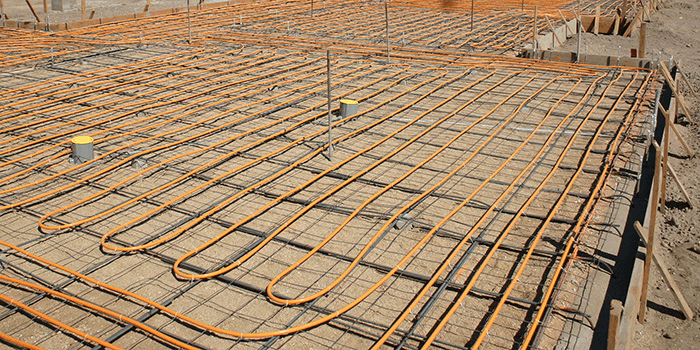
Radiant Floor Heating: No Shoes Required
A hydronic radiant floor heating system in concrete slab
There are numerous ways to heat living space. Some more desirable than others. Among them are forced-air heating, baseboard heating, gas burners, electric heating elements, space heaters, passive solar design, and radiant heating. Although each heating method has its pros and cons along with its own unique characteristics, radiant heating stands out for numerous reasons.
Radiant floor heating, also commonly referred to as underfloor heating, is a popular central heating system that supplies heat directly to the floors surface keeping it warm to the touch while radiating up into the living space above.
There are three types of radiant floor heat which consist of “Radiant Air Floors,” “Electric Radiant Floors,” and “Hydronic Radiant Floors.”
The first type, Radiant Air Floors, of radiant floor heating utilizes air as the heat-transferring medium and is rarely installed for residential use due to the limited amount of heat air holds. Electric Radiant Floors is the second type of radiant floor heating and utilizes electric cables or electrically conductive plastic mats installed beneath the floor covering to heat the space above through radiation and convection. This type of heating system is best used in applications where the floor has significant thermal mass to store the heat for longer periods of time. The third and most popular type of radiant heating is hydronic. This system pumps a mixture of heated water and anti-freeze from a boiler through looped tubing that is laid beneath the floor’s surface (as depicted above) and controlled by multiple heating zones which fine tune the amount of heat being delivered to different rooms.
Hydronic systems utilize a variety of energy sources to heat the liquid mixture, which include standard gas- or oil-fired boilers, wood-fired boilers, solar water heaters, or a combination of these sources. Though materials such as copper and steel pipe were used in the past, the tubes today are generally made from polyethylene, which are more durable. And although the cost of installation varies by project size, location, heating type, floor covering, and labor, it is widely believed to be the most cost-effective of the three radiant heating systems. Hydronic systems also use very little electricity and benefit homes in areas that would otherwise be subject to the high electricity costs. There are also two types of floor installations that categorize radiant floor heating. They are commonly referred to as a “wet installation” and “dry installation.” A wet installation refers to a system that utilizes a large thermal mass of concrete slab floor or lightweight concrete over wood subfloor. A dry installation on the other hand refers to the procedure of enclosing the radiant floor tubing between two layers of plywood or attaching the tubing beneath the finish floor or subfloor.
Ceramic tile conducts heat well and adds thermal storage, which is one reason it is the most popular and effective floor covering used in radiant floor heating. Wood, vinyl, linoleum, and carpeting may also be used as floor covering. However, coverings such as carpet tend to insulate the floor from the living space and thus decrease the efficiency. Radiant floor heating is said to be more efficient than baseboard or forced-air heating, is generally quieter, and offers a desirable temperature gradient when compared with alternative heating sources. One of the largest selling points of a heated floor surface is the added comfort and warmth. Imagine! No more ice-cold floors! You can finally do away with air register vents and radiators, which have a way of limiting your furniture placement time and time again. You can do away with noisy mechanical systems that blow hot air and dust; irritating your guest’s allergies while the heat rises to the ceiling keeping the upstairs uncomfortably hot while the downstairs remains cold. And so on… Choosing a heating system will affect your comfort in every room, every single day of the year. Despite the initial installation costs, which can be higher but easily offset with government incentives and rebates, radiant floor heating provides the added comfort that many of us never experience with older, drafty, or conventional heated homes. A well-operated radiant heating system with a programmable thermostat can save you hundreds of dollars on home heating bills. In most cases, you should consult with a reputable heating contractor to verify if radiant floor heating is sensible for your particular application. In some scenarios, it can be less energy efficient than alternative heating methods such as forced-air heating.
If you are looking for the added comfort and efficiency that seems out-of-place in your existing structure or simply interested in building a house or structure with an emphasis on energy efficiency, perhaps the proper material choices and conscious structure configuration found in radiant floor heating is worth consideration. States may also offer financial incentives if you decide to boost energy and efficiency by upgrading your home or commercial heating systems. For answers and more information on tax rebates and incentives visit the following link: Database of State Incentives for Renewable Energy (DSIRE).
References:
www.energy.gov on Radiant Heating
Have a similar project in mind?
Contact us today to see how we can best serve you on your next building project.
Tel: +1 (805) 466-7674
E-mail: Contact Form
